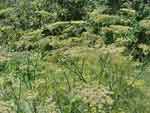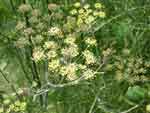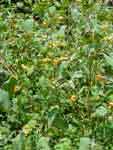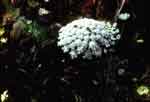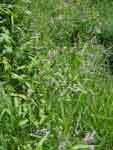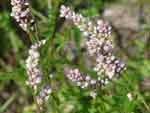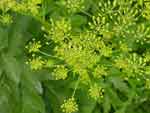SPRING |
SUMMER |
WINTER |
Summer
| Parsnip (Umbellifera) - commonly found along fence rows, this plant can be an important food source for syrphid flies, ladybugs, and parasitic wasps (especially the ones that attack fly puparia, like Spalangia and other Pteromalid wasps). | Buckwheat – will flower every 30-45 days or
so if left to go to seed. We find lots of ladybugs and syrphid flies on
buckwheat flowers. |
Parsnip in full bloom. |
A mix of yarrow, sunflowers, Johnny jump-ups, and Fava beans
surrounds a potato plot. These plants help to draw in and conserve ladybugs
that will eat Colorado Potato Beetle eggs in the potatoes. |
Bronze Fennel (one of my favorites). All parts of the plant are edible. Young plants get aphids in the spring, which can jump start ladybugs, mantids, and syrphid fly populations. |
| Crown Vetch – Legumes like vetches are important
sources of food for aphids and other soft bodied insects, which in turn
draw in lots of ladybugs. |
Japanese Knotweed (Smartweed Family Polygonaceae)
- has extrafloral nectaries at the base of each leaf, and the delicate
featherlike white flower blossoms at the end of 10 foot stalks is an important
food source especially for flies and wasps. Japanese knotweed could be
considered a noxious weed. Other plants in this family are Pennsylvania
smartweed and Lady’s thumb. |
Jerusalem Artichoke – Compositae – Sunflower
Family – Artichokes and Sunflowers support aphids and are easily
searched by ladybugs – these plants are consistently attractive to
ladybugs in the field and greenhouse. |
Jewelweed/Touch Me Not – Bees and other hymenoptera
like these flowers. Found usually in cool, wet spots. |
Kenafe (Hibiscus cannabis) - Has extrafloral nectaries
at the base of the leaves. Is an important food source for larger wasps.
Another plant with similar properties is the sweet potato. |
| Kenafe: bordering a peanut field to protect the peanuts
against white grubs (Scarab beetle larvae). |
Anise Hyssop (Mint) - Mints are important food plants for
bees and wasps in the spring and summer. Shown here are a honey bee and
a native bumble bee visiting the mint plant’s flowers. |
The Chef harvests Lavender, next to the Patrina plants,
as a seasoning. These plants serve multiple purposes – the chef uses
them in the kitchen and they also serve as important beneficial insect
food plants. |
Queen Anne’s Lace (Umbellifera) with a Scoliid wasp
(attacks white grubs). In the 1920’s, USDA researchers showed that
Queen Anne’s Lace was an important food source for parasitic wasps
that attack white grubs. |
Queen Anne’s Lace again, showing another favorite visitor
– ladybugs. In this case these are the C-Mac ladybugs. They are feeding
on nectar and pollen from the flowers. |
| Smartweeds – Polygonacea. Pennsylvania smartweed along
the field border. We see lots of syrphid flies visiting these flowers. |
Yellow Sweet Clover – Along with its white cousin,
White Sweet Clover, these can have both aphids and also be an important
flower feeding site for beneficial insects. Honeybees can make good honey
from this plant. |
Smartweed – Pennsylvania Smartweed closeup of flowers. |
Cow Parsnip Flowers (Umbellifera) showing feeding by syrphid
flies. |
Tansy foliage with a Harmonia ladybug. |
